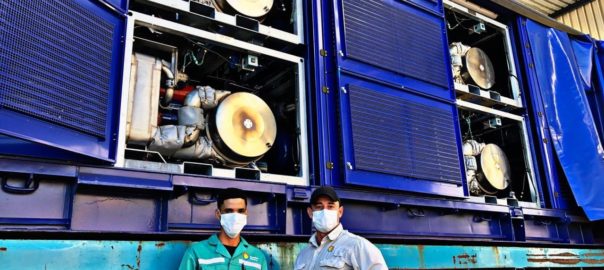Swedish Stirling AB’s container-based energy recycling solution is taking off in South Africa’s ferrochrome sector, with two of the largest producers on board with the technology.
Based close to Gothenburg, Swedish Stirling Group is a clean tech company with a mission to scale up the conversion of thermal energy to electricity.
It is the company’s latest product – the PWR BLOK 400-F – that is finding favour in South Africa. This is a unique proprietary solution that uses Swedish Stirling’s Stirling engines for recovering energy from industrial residual and flare gases and converting them to 100% carbon-neutral electricity at a high rate of efficiency, according to the company.
The PWR BLOK 400-F contains 14 Stirling engines and delivers a net output of 400 kW.
Citing an independent certification, Swedish Stirling says the PWR BLOK is the cheapest way to generate electricity that exists today, yielding greater CO2 savings per Euro invested than any other type of energy.
Ferrochrome is renowned for being an energy-intensive process and load shedding is a common practice in power-constrained South Africa, hence the reason why it has been one of the frontrunners in adopting this technology.
Swedish Stirling explained: “Many industrial applications produce by-products in the form of gases (residual gas) that are currently burned without harnessing its energy content. Several solutions have been tried to recycle the energy in the gases.
“In the ferrochrome industry in South Africa, producers have tried to recover the energy using internal combustion engines, gas and steam turbines, but all solutions have failed. The reason is usually that the gas is of such uneven quality that most engines with internal combustion don’t work, or the technical solutions are extremely costly.
“The Stirling engine, on the other hand, is, due to its external combustion, almost insensitive to the type of gas that is burned or the quality of the gas in question. Therefore, it is now possible to start converting these residual gases into climate-smart electricity with PWR BLOK.”
And, this is exactly what is happening.
After installing a test PWR BLOK at Afarak Mogale’s smelter in South Africa over a year ago, the company has sealed contracts with Glencore and Samancor.
In the recent March quarter results, Swedish Stirling CEO, Gunnar Larsson, said: “Together, these (companies’ output) account for over 90% of the entire market in the country. This gives us a solid base for a wider-scale roll-out of the PWR BLOK in South Africa in the coming years.”
The agreement with Glencore will see it install and deliver up to 25 PWR BLOKs, generating 9.9 MW, to the Lydenburg smelter, while Samancor has signed up for a pilot facility with one PWR BLOK unit at the TC Smelter facility.
The company also, earlier this year, arranged a tour of the Mogale smelter for interested parties to spur further enquiries.
While the spread of COVID-19 has somewhat affected the company hitting its deadlines for these projects, it made progress with the Samancor delivery early last month, confirming that, after spending a number of weeks on a ship in Durban Harbour during the COVID-19 lockdown in South Africa, a PWR BLOK 2 unit was unloaded for transport to Samancor’s TC Smelter (pictured).
The company still hopes to install and commission the facility at TC Smelter during the June quarter as planned.
The agreement with Glencore’s Lydenburg smelter, meanwhile, could see carbon dioxide emissions from the smelter reduce by more than 80,000 t/y, due to the reduced need for purchased electricity, Swedish Stirling previously said.







